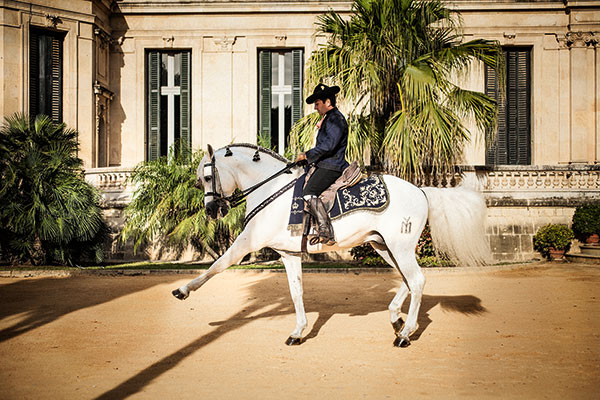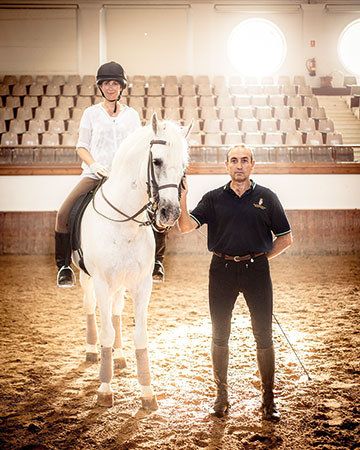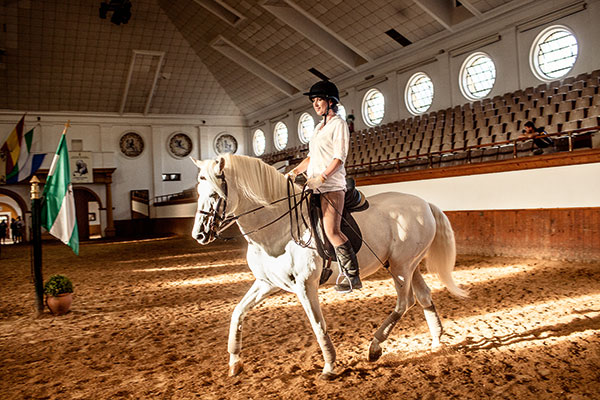FT Masterclass: Dressage with the Royal Andalusian School of Equestrian Art

Simply sign up to the Life & Arts myFT Digest -- delivered directly to your inbox.
With 30 years of riding experience under my belt it ought to be no trouble to trot a horse around an arena and turn a circle or two. However, it is quickly apparent that Bolero, the half-ton of stallion that I am attempting to pilot as he bounds along with what appear to be springs on his feet, possesses considerably more horsepower than I am used to.
Bolero stands 16.2 hands tall and has been trained since he was three in dressage, a discipline at once so elegant and so physically demanding for both mount and rider that it is often described as equestrian ballet. Bolero is an Andalusian horse, with a snowy coat and silken mane. For hundreds of years, his forefathers were prized as war horses because of their strength, speed and bravery. Their distinctive high-stepping movement and crested necks mean they are also ideal for performing the athletic movements required at the top level of dressage.
My instructor at The Royal Andalusian School of Equestrian Art is Juan Rubio Martinez. Next month, he will be part of a team of horses and riders from the school performing at Olympia – its first London appearance in 40 years. For now, though, Rubio Martinez is attempting to marry my skills with those of my mount. He is making a good fist of not giggling at the pairing of Bolero, gliding along in a perfect embodiment of grace plus strength, and me, red-faced and puffing as I struggle to accustom myself to those high-stepping paces. Rubio Martinez’s advice is to relax. Although highly sensitive, Bolero is too well trained to object to his hopeless new jockey. “Do not panic,” Rubio Martinez tells me, repeatedly, as I graduate from walking around the arena to trotting some circles before, gingerly, putting Bolero into canter.
Dressage is supposed to look serene and effortless, which can make it appear easy. It is not. Bolero may be one of the oldest of the 118 horses at the school but riding him is like balancing on the edge of a live volcano, holding your breath and hoping it does not erupt.
Rubio Martinez’s own education in dressage began 30 years ago. Now 48, he was brought up in Peñaflor, a village between Seville and Córdoba. “From a young age, I loved horses but my riding was just out with friends, not serious,” he says. But as a teenager, he saw a television programme about the school and was entranced. He wrote asking if he could be taken on as a student and, at the age of 18, he moved to the school in Jerez de la Frontera. At first, most of his time was spent mucking out and grooming, with riding sessions squeezed in each day. “It was not easy,” he says. “I knew nothing about dressage at all and it was very different from the easy riding I was used to.” Not that he minded. “It was a privilege, my dream, and I was getting money at the same time.” Now, he says, “I enjoy every day, and I don’t think that most people can say that.”

After eight years Rubio Martinez was promoted to the role of rider, allowing him to take part in the school’s regular shows, then he was appointed teacher-rider, training new generations of students. He is now a teacher-rider specialist, which means that Bolero is not the only one experiencing a comedown during my lesson.
Now that Bolero and I have warmed up, Rubio Martinez decides it is time I am shown some of the most advanced dressage movements. The piaffe, for example, is an on-the-spot trot. To achieve this, I must sit perfectly upright and still (while remaining relaxed), very subtly increase my contact on the reins and, equally tactfully, squeeze with my legs. But dressage horses are highly sensitive beasts. Bolero can piaffe in his sleep but he is used to precise aids performed by expert riders. Something – I have no idea what – about the position of my hands or the alignment of my back or the distribution of my weight is not pleasing and he goes into high-speed reverse.
Rubio Martinez manages to grab the reins just before we hit the ménage wall and his reassuring presence soon sees Bolero lifting his feet in a perfectly balanced piaffe, before demonstrating the Spanish walk, a kind of equine cancan where the horse kicks each foreleg out straight in front of him as he walks. Unsurprisingly, Rubio Martinez decides to omit some of the showier moves in Bolero’s repertoire from my lesson. These are challenging manoeuvres known as haute école (high school) and include the capriole, where the horse jumps into the air before kicking out its hind legs. Then there is the levade, where the horse rears up and balances on its hind legs. And so I give my borrowed Andalucian a pat and dismount, to discover that my legs are wobbling from a combination of relief and exhaustion. Bolero, of course, has not broken a sweat.
Later, Rubio Martinez shows me how it is really done in the school’s daily show, riding a firecracker of a bay that makes Bolero look like a seaside donkey. Rubio Martinez retains his composure throughout, barely moving and giving virtually no indication of the skill it takes to contain a horse in such a heightened state of fitness and fiery anticipation.

“Dressage is a philosophy,” Rubio Martinez had told me earlier. “It is very technical, and the power comes from the horse. It can only work when you understand the horse and the horse understands you. At this moment there is complicity between you that is impossible to explain.” I may have a long way to go to reach this higher plain but Bolero and I did enjoy a brief moment of mutual understanding. Back in his stable I offered him a sugar lump. As he took it from my hand, he gave me a sidelong look. I think we both knew that his tolerance merited a far greater reward.
The Royal Andalucian School of Equestrian Art performs at Olympia, the London International Horse Show, which runs from December 16 to December 22, see www.olympiahorseshow.com. For information on the school see www.realescuela.org
Comments